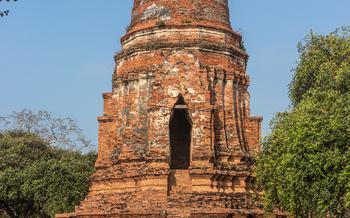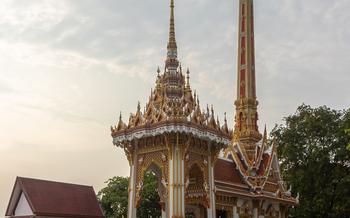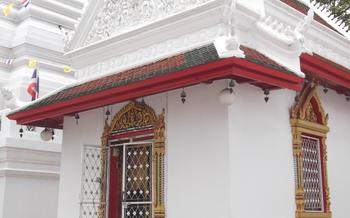
Wat Tham Phra Phothisat
- Wat Tham Phra Phothisat: A Journey Through History and Spirituality in Saraburi
- Exploring the Cave
- The Reclining Buddha Image
- Ordination Hall and Monk's Quarters
- Festivals and Events
- Pilgrimage and Spiritual Retreats
- Surrounding Natural Beauty
- Local Cuisine and Restaurants
- Getting There and Transportation
- Accommodation Options
- Tour Guides and Interpreters
- Photography and Videography
- Insider Tip: Unveiling Hidden Gems and Unique Experiences
Wat Tham Phra Phothisat: A Journey Through History and Spirituality in Saraburi
Wat Tham Phra Phothisat, nestled in the picturesque province of Saraburi, is a testament to Thailand's rich cultural heritage and deep spiritual traditions. This ancient temple, with its sacred cave and awe-inspiring reclining Buddha statue, has captivated the hearts and minds of pilgrims and visitors for centuries.
The temple's history is intertwined with legends and folklore, dating back to the Ayutthaya period in the 14th century. According to local tales, a group of hunters stumbled upon a mysterious cave inhabited by a revered monk. Inspired by this encounter, they constructed a small shrine within the cave, marking the humble beginnings of Wat Tham Phra Phothisat.
Over the years, the temple underwent significant expansions and renovations. In the 19th century, during the reign of King Rama III, the temple's main viharn (assembly hall) was built, showcasing intricate architectural details and exquisite murals depicting Buddhist teachings. The temple's fame grew, attracting pilgrims from far and wide, who sought blessings and spiritual guidance within its sacred walls.
Wat Tham Phra Phothisat stands as a testament to the enduring spirit of Thai artisans and the devotion of the Buddhist faithful. Its unique architectural style, blending traditional Thai elements with influences from neighboring countries, reflects the rich cultural exchange that has shaped Thailand's artistic heritage. Ongoing restoration projects ensure that this magnificent temple continues to inspire and captivate future generations.
Exploring the Cave
The Tham Phra Phothisat Cave, located within the temple complex, is a natural wonder that adds to the spiritual significance of Wat Tham Phra Phothisat. The cave's geological formations, with stalactites and stalagmites creating intricate patterns, are a sight to behold. Its natural beauty and serene atmosphere have made it a popular destination for pilgrims and visitors alike.
Legends and myths surround the cave, enhancing its spiritual importance. It is believed to be the meditation site of a highly revered monk, Luang Pu Thuat. According to local folklore, the monk achieved enlightenment within the cave and left his footprints imprinted on the cave walls, which are still visible today. These footprints are considered sacred and are a major attraction for pilgrims who come to pay homage and seek blessings.
Exploring the Tham Phra Phothisat Cave is an awe-inspiring experience. Visitors can marvel at the intricate rock formations, admire the natural beauty, and feel a sense of peace and tranquility. To ensure a safe and enjoyable exploration, it is advisable to wear comfortable shoes and bring a flashlight or headlamp. The cave can be slippery, so caution is advised when navigating the uneven terrain.
The Reclining Buddha Image
Artistic and Cultural Significance
The reclining Buddha statue at Wat Tham Phra Phothisat is a masterpiece of Buddhist art and a symbol of the temple's spiritual significance. Carved from a single block of sandstone, the statue measures an impressive 18 meters in length and 5 meters in height, exuding an aura of serenity and tranquility. Its intricate details, graceful lines, and serene expression showcase the exceptional craftsmanship and artistic prowess of ancient Thai artisans.
Symbolism and Religious Teachings
The reclining Buddha represents the final moments of the Buddha's earthly existence when he attained Parinirvana, or the ultimate state of liberation from the cycle of rebirth. The statue's posture, with the right hand supporting the head and the left hand resting peacefully on the thigh, symbolizes the Buddha's teachings on impermanence, detachment, and the pursuit of enlightenment.
Rituals and Offerings
Devotees pay homage to the reclining Buddha by offering flowers, candles, and incense, seeking blessings, good fortune, and spiritual guidance. They often prostrate themselves before the statue, expressing their reverence and gratitude for the Buddha's teachings. The act of offering and prostration is believed to accumulate merit and purify the mind and heart.
Ordination Hall and Monk's Quarters
Wat Tham Phra Phothisat boasts an elegant ordination hall that serves as a sacred space for the initiation of young men into the Buddhist monastic order. The hall is adorned with intricate carvings and colorful murals depicting scenes from the Buddha's life and teachings. The ordination ceremony, known as "upasampada," is a significant ritual in which candidates make a formal commitment to the monastic life and receive their robes and alms bowls.
Beyond the ordination hall lies the monks' quarters, where the resident monks reside and carry out their daily routines. Visitors are welcome to interact with the monks and gain insights into their lives and the teachings of Buddhism. The monks often engage in meditation, chanting, and study, and they are always willing to share their knowledge and wisdom with those who seek it.
Festivals and Events
Wat Tham Phra Phothisat is renowned for its vibrant festivals and special events that attract both local devotees and international visitors. One of the most significant festivals is the annual Phra Phothisat Fair, held during the month of March. This grand celebration honors the temple's namesake, Phra Phothisat, and features a range of colorful processions, traditional performances, and cultural exhibitions. Devotees gather to pay homage to the sacred Buddha images and participate in merit-making activities, creating an atmosphere of devotion and festivity.
Another notable event is the Kathin Ceremony, which typically takes place in October or November. During this ceremony, new robes are offered to the monks of the temple as a symbol of support and gratitude. The ceremony includes a procession of monks and laypeople carrying the robes, followed by chanting, prayers, and the تقديم of alms. Visitors are welcome to participate in the ceremony and experience the deeply spiritual and communal nature of this Buddhist tradition.
Pilgrimage and Spiritual Retreats
Wat Tham Phra Phothisat holds immense significance as a pilgrimage site for Buddhists from around the world. Devotees flock to the temple to pay homage to the revered reclining Buddha statue and seek spiritual guidance from the resident monks. The temple offers a serene and conducive environment for meditation and spiritual practices, attracting both experienced practitioners and those seeking a deeper connection with Buddhism.
For those seeking a transformative spiritual experience, Wat Tham Phra Phothisat provides opportunities for meditation retreats and spiritual workshops. These programs are designed to introduce participants to the principles of Buddhism, teach meditation techniques, and guide them on a journey of self-discovery and inner peace. Accommodation and facilities are available for pilgrims and retreat participants, ensuring a comfortable and supportive environment for their spiritual pursuits.
To fully immerse in the sacred atmosphere of the temple, visitors are encouraged to observe respectful behavior and maintain the sanctity of the grounds. This includes dressing modestly, speaking softly, and refraining from disruptive activities. By following these guidelines, visitors can contribute to the peaceful and meditative ambiance that permeates Wat Tham Phra Phothisat.
Surrounding Natural Beauty
Wat Tham Phra Phothisat is nestled amidst a stunning natural landscape, offering visitors a chance to immerse themselves in the beauty of Thailand's countryside. The temple grounds are surrounded by lush greenery, with towering trees, colorful flowers, and fragrant plants creating a serene and tranquil atmosphere. Visitors can take a leisurely stroll through the temple grounds, admiring the natural beauty that surrounds them. There are also several scenic viewpoints within the temple complex, offering panoramic views of the surrounding landscape. For those who enjoy hiking or trekking, there are several trails that lead through the nearby hills and forests, providing an opportunity to explore the natural wonders of the area. Birdwatching enthusiasts can also enjoy spotting a variety of bird species that inhabit the temple grounds and the surrounding forest. The temple's natural beauty is a reminder of the harmony between nature and spirituality, and it provides visitors with a sense of peace and tranquility that can only be found in such a serene setting.
Local Cuisine and Restaurants
Wat Tham Phra Phothisat is situated in a region renowned for its culinary delights. Visitors can savor a diverse array of local dishes and delicacies near the temple. An array of popular restaurants and food stalls line the streets, offering authentic Thai cuisine that tantalizes the taste buds.
For those seeking a culinary adventure, trying local specialties is a must. Sample the flavorful "Khao Soi," a northern Thai curry noodle dish, or indulge in the aromatic "Som Tum," a spicy green papaya salad. Don't miss the chance to savor "Sai krok Isan," a unique fermented pork sausage that is a regional specialty.
For those with dietary preferences, vegetarian and vegan options are readily available. Many restaurants offer meat-free versions of popular Thai dishes, such as "Pad Thai" and "Massaman Curry." Fresh fruits and vegetables are also abundant, providing a healthy and refreshing alternative.
When visiting Wat Tham Phra Phothisat, be sure to come with an empty stomach and a sense of adventure. The local cuisine is an integral part of the cultural experience, and sampling the delicious offerings is a fantastic way to immerse oneself in the vibrant flavors of Saraburi.
Getting There and Transportation
Navigating Your Way to Wat Tham Phra Phothisat
Reaching Wat Tham Phra Phothisat involves a scenic journey from Bangkok, Thailand's vibrant capital city. The temple's accessibility from major transportation hubs makes it convenient for visitors to embark on a pilgrimage or spiritual retreat.
Public Transportation:
-
Buses: Regular bus services connect Bangkok's Southern Bus Terminal (Sai Tai Mai) to Saraburi. From Saraburi, local buses or songthaews (shared taxis) can be taken to Wat Tham Phra Phothisat.
-
Trains: Trains depart from Bangkok's Hua Lamphong Railway Station to Saraburi Railway Station. From there, visitors can take a taxi or songthaew to the temple.
Private Transportation:
-
Taxis: Taxis are readily available in Bangkok and can be hired for a direct ride to Wat Tham Phra Phothisat. The journey typically takes around 2 hours, depending on traffic conditions.
-
Rental Cars: For those seeking flexibility and independence, renting a car in Bangkok is a convenient option. The drive to Wat Tham Phra Phothisat offers picturesque landscapes and the freedom to explore the surrounding areas at your own pace.
Parking Facilities:
The temple provides ample parking space for visitors arriving by private vehicles. Parking is generally free of charge, and designated areas are available for buses and cars.
Accessibility:
Wat Tham Phra Phothisat is wheelchair accessible, with ramps and designated pathways catering to visitors with disabilities. The temple's staff is also available to assist with any special needs or requirements.
Accommodation Options
Saraburi offers a diverse range of accommodation options for travelers visiting Wat Tham Phra Phothisat, catering to different budgets and preferences. For those seeking convenience and proximity to the temple, numerous guesthouses and budget hotels are located within walking distance. These options provide basic amenities and comfortable accommodations at affordable rates.
For a more luxurious experience, several resorts and boutique hotels are situated in the surrounding area, offering amenities such as swimming pools, spas, and fine dining restaurants. These establishments provide a tranquil retreat amidst the natural beauty of Saraburi.
To ensure a hassle-free stay, it is advisable to book accommodations in advance, especially during peak tourist seasons or major festivals. Online booking platforms and travel agents can assist in finding the best deals and availability.
Travelers with specific accommodation preferences or requirements, such as family-friendly resorts or accessible rooms for individuals with disabilities, should research and make reservations accordingly. Saraburi's hospitality industry is well-equipped to cater to diverse needs, ensuring a comfortable and enjoyable stay for all visitors.
Tour Guides and Interpreters
For a more immersive and educational experience, consider hiring a tour guide or interpreter. Knowledgeable guides can provide in-depth insights into the temple's history, religious significance, and cultural traditions. They can explain the symbolism behind the Buddha statues, the rituals performed by devotees, and the daily life of the resident monks.
Booking a tour guide in advance is recommended, especially during peak tourist seasons. Online platforms and local tourist information centers can help you find reputable and experienced guides. It's important to negotiate a fair price and ensure that the guide is licensed and knowledgeable.
With a guide by your side, you'll gain a deeper understanding of Wat Tham Phra Phothisat and its spiritual significance. They can answer your questions, point out hidden details, and help you navigate the temple complex with ease.
Photography and Videography
Respectful Photo and Video Capture
When visiting Wat Tham Phra Phothisat, visitors are welcome to take photos and videos to capture the beauty and spirituality of the temple. However, it is important to be respectful of the religious significance of the site and follow proper etiquette.
-
Be Mindful of Ceremonies: Avoid taking photos or videos during religious ceremonies or rituals unless explicitly permitted. Respect the privacy and solemnity of these events.
-
Respect Individual Privacy: Ask for permission before photographing or filming individuals, especially monks. Be mindful of their personal space and wishes.
-
Capture the Essence: Focus on capturing the temple's architecture, statues, and natural surroundings without disturbing the serenity of the site.
-
Obey Copyright Laws: Remember that the images and videos you take are subject to copyright laws. Obtain permission if you intend to use them for commercial purposes or share them publicly.
Insider Tip: Unveiling Hidden Gems and Unique Experiences
Beyond the main attractions at Wat Tham Phra Phothisat, there are hidden gems waiting to be discovered by curious travelers. One such spot is the secluded meditation cave, nestled deeper into the mountain. This serene space offers a tranquil environment for visitors to connect with their inner selves and find moments of peace and reflection.
For those seeking a unique perspective, the viewpoint atop the mountain provides breathtaking panoramic views of the surrounding landscape. The climb may be challenging, but the reward is worth the effort. From this vantage point, visitors can admire the lush greenery, rolling hills, and the distant cityscape, creating lasting memories of their temple visit.
To avoid the crowds and experience the temple's tranquility, consider visiting during the early morning or late afternoon hours. These times offer a more intimate and serene atmosphere, allowing visitors to fully immerse themselves in the temple's spiritual ambiance.
If time permits, combine your visit to Wat Tham Phra Phothisat with other attractions in Saraburi or nearby provinces. The province is home to several other stunning temples, historical sites, and natural wonders. Plan an itinerary that allows you to explore the rich cultural heritage and diverse landscapes that Saraburi has to offer.



